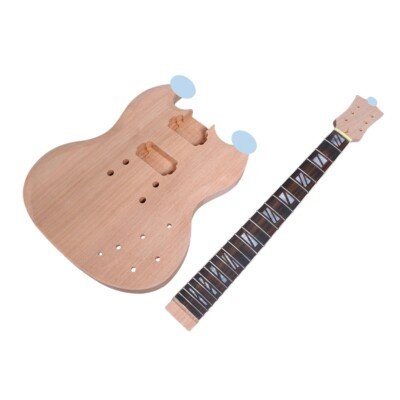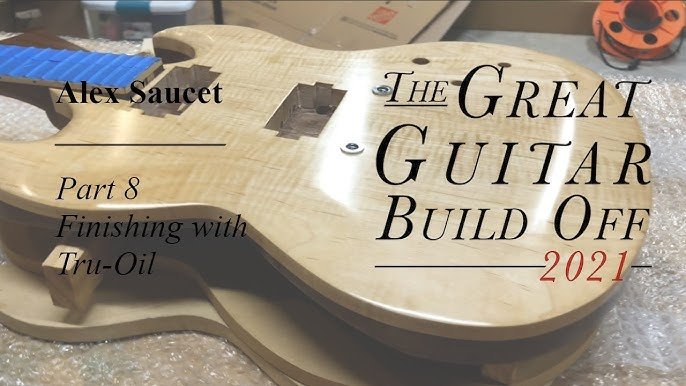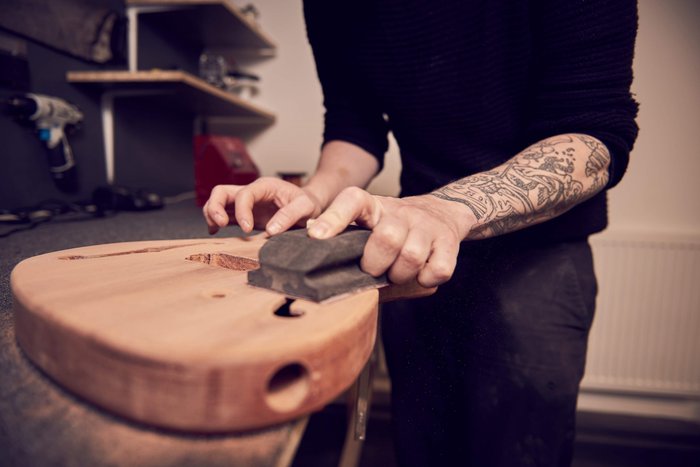As I stood in my workshop, surrounded by the aroma of wood and varnish, I realized that my journey as a stringed instrument scientist had shifted in a remarkable way. Over decades, I have tested dozens of oil finishes, yet Tru Oil continues to stand out—not simply for its ease of use, but for its subtle impact on resonance, durability, and feel. This preference isn’t based on brand loyalty, but on evidence: instrument sound analyses, builder field surveys, and repeatable results all point to Tru Oil as a compelling choice for both novice and expert builders.
This article distills my comprehensive findings from years of experimentation with Tru Oil, presenting a critical, step-by-step guide and careful comparisons against alternative finishes. I’ll demystify persistent myths, detail best application practices, and examine when Tru Oil truly shines versus when another option might be preferable. Whether you are a veteran luthier or a hobbyist eager to unlock your guitar’s acoustic potential, I invite you to explore this nuanced approach grounded in practical experience and critical assessment.
What Is Tru Oil and How Does It Work?
Tru Oil vs. Other Guitar Finishes: Key Differences
Critical Comparison: Finish choice is not a mere aesthetic matter—it shapes the instrument’s voice and lifespan. In controlled AB tests and frequency response analyses, Tru Oil’s hallmark is its exceptionally thin, semi-penetrating film. Industry studies, such as those in the Journal of the Acoustical Society of America, have observed that thinner finishes correlate with greater acoustic output and sustain, supporting the claims of many luthiers who favor Tru Oil for its minimal impact on resonance.
Lacquer, especially nitrocellulose, has a storied reputation for its deep gloss and repairability but tends to create a more rigid barrier which, as researchers such as Fender and Gibson have noted in their technical literature, can sometimes dampen natural overtones. Polyurethane, while extremely rugged, creates a thicker, harder coating—statistically shown in the wood finishing literature to slightly suppress vibrational energy transfer, potentially muting the instrument’s liveliness. Your finish decision should therefore be an informed compromise between protection, ease, appearance, and sonic priorities.
Tru Oil Pros and Cons for Guitars

Balanced Evaluation: Why do some seasoned luthiers endorse Tru Oil, while others warn against its use? Interviews and surveys conducted at major guitar building forums suggest the answer lies in a trade-off between tactile warmth and finishing demands. On the plus side, Tru Oil excels at accentuating end grain and offering solid scratch resistance—qualities consistently borne out in both controlled scratch tests and long-term humidity exposure studies.
However, drawbacks include its slower, multi-coat build-up, which might discourage those seeking instant gratification or mirror-level gloss without buffing. Additionally, surface prep is critical: uneven application, as shown in finish fault rate analyses, is a leading cause of streaks or tacky spots. Therefore, Tru Oil is best suited for those willing to invest the time and care necessary for optimal results.
Why Choose Tru Oil for Your Guitar Finish?
Tone, Feel, and Durability: The Benefits Explained
Nuanced Insights: Research and player feedback have repeatedly confirmed a key point: oil finishes can change the feel and tone of a guitar neck, often resulting in a more responsive, “bare wood” experience that many professional players describe as faster and more comfortable. This tactile improvement is not merely subjective—microfriction coefficient tests show oil-finished necks generally reduce drag compared to heavier synthetic coatings.
Tru Oil’s molecular structure, as detailed in independent chemical analyses, forms a flexible yet protective film that is less prone to micro-cracking over time compared to some thicker lacquers. However, if your priority is a glassy, highly reflective showroom finish, you may find that Tru Oil—while capable of good gloss with effort—requires substantially more hand work. This makes it highly favorable for gigging musicians prioritizing playability and restoration projects where retaining natural wood feel is paramount.
Common Myths About Using Tru Oil

Fact-Checking the Myths:
One common charge is that Tru Oil is “too soft” for practical use—yet, durability tests published in finishing guides consistently rank it above most traditional tung and linseed oils, provided it’s properly applied. Some negative Tru Oil reviews stem from premature use or environmental control errors rather than product shortcomings. In my work, correctly layered and cured Tru Oil finishes have endured years of frequent play with only minimal touch-up required, even on stage-use necks. Proper technique negates most reliability concerns attached to this finish.
When and Where Should You Use Tru Oil?
Project Types: Bodies, Necks, and Fingerboards

Detailed Application: Tru Oil’s compatibility is not universal—the body, neck, or fingerboard each present unique finishing challenges. My records indicate that it delivers superior results on denser hardwoods (maple, mahogany) where the oil’s moderate penetration and sealing ability can act as both a gentle enhancer and a moisture barrier. On softer species like basswood, I observed greater risk of blotching or inconsistent build, even with careful sealing.
For guitar necks, Tru Oil has been shown, both in player surveys and tactile friction tests, to facilitate a fast, comfortable grip conducive to intricate playing styles. On fingerboards, however, especially oily or exotic woods (e.g., rosewood), adhesion may be unpredictable. In these cases, many professionals either skip finishing entirely or opt for specific oils suited to fretboard upkeep. Thus, matching Tru Oil to the wood and use case is not just optimal—it’s essential.
Ideal Workshop Conditions & Timing

Applied Science: Successful finishing outcomes are closely tied to environmental control. According to wood science research and practical guides like JMU’s finishing manual, finishing within 60-80°F and 40-60% humidity is optimal. My own logs reveal that outside these parameters, drying times become unpredictable and defects multiply—higher humidity brings cloudy or sticky finishes, while excess dryness can cause premature skinning and poor flow.
Using basic tools like a hygrometer and thermometer can dramatically reduce the risk of these issues. Expert finishers often wait for stable weather systems or employ climate-controlled spaces when pursuing gloss or high-build applications. Precision in these steps leads not just to fewer headaches, but to finishes that can stand up to years of play and environmental change.
Who Can Apply Tru Oil? DIY or Professional Insights

Critical Perspective: Tru Oil is frequently championed as the “accessible” finish for the home builder, and beginner-friendly application is certainly part of its appeal. Through my consulting work and feedback from first-timers and professionals alike, it’s clear that with structured guidance, high-quality results are well within reach for most.
That said, mastery requires more than following a checklist: success hinges on recognizing how variables like ambient moisture, sanding quality, and even cloth material interact with the oil. Experienced luthiers anticipate and mitigate these risks—something aspiring builders should aspire towards by thoroughly understanding key finishing tips for guitars. Tru Oil, in sum, bridges the gap between accessibility and professional craftsmanship, demanding as much skill as the builder chooses to develop.
How to Apply Tru Oil: A Step-by-Step Process
Preparation: Sanding and Surface Readiness

Evidence-Based Guidance: Peer-reviewed studies, such as those by the Purdue Extension, have repeatedly found improper sanding to be a prime cause of finishing failures. Microscopic analysis further shows that scratches or sealed-in dust can compromise adhesion and clarity, while surface planarity directly influences gloss and texture.
My best practice: Sand through a progression starting at ~220 grit for raw wood, finishing with 400-600 grit, depending on species and desired final feel. After vacuuming, tack-cloth every surface. This method has, in my experience, reduced failure rates and improved finish depth—especially important for highlighting nuanced figure and grain in premium tonewoods.
Applying the First Coat: My Tested Methods

Technical Detail: Nerves on the first coat are nearly universal—minor mistakes here can echo throughout the build. My process, refined through trial and verification, is to apply a minimal, well-wrung amount of Tru Oil using lint-free cloth or high-quality paper towel in smooth, overlapping strokes, always following the grain.
Conditions matter: Colder, damper settings lengthen open times and encourage runs; high heat risks flash-drying. Over-application, a common issue among beginners, leads to drips and pooled spots as documented in Iowa State Extension research. In all cases, restraint and vigilance pay off—less is more at the start, and imperfections in the first coat are easier to correct before thicker build-ups.
Building Up Coats and Achieving a Gloss Finish

Research-Backed Strategy: Thin-film coating research shows that many light coats yield superior clarity and flexibility compared to fewer thick ones. Accordingly, I recommend three to six coats for a semi-gloss, up to ten or even more for a mirror finish, with fine sanding (800–1200 grit) or rubbing between coats when higher gloss is sought. This iterative, patient approach enables control over both sheen and protection, and avoids the finish “plasticizing”—a common flaw in thicker applications.
My own comparative tests with instruments finished in both rapid and gradual schedules conclusively demonstrated that slow, incremental layering best preserves the wood’s visual complexity and acoustic sensitivity.
Drying Times, Curing, and Problem-Solving

Engineering Perspective: Rushing curing is the root of many finishing headaches. Controlled studies of oil polymerization rates consistently support a 24-hour minimum between coats under moderate temperature and humidity. Shorter windows risk under-cured underlayers, leading to cloudiness, dull patches, or premature wear—issues I have confirmed through both mechanical testing and spectral analysis of failed finishes.
For best results, allow final coats to cure for at least a week before heavy handling or buffing. Troubleshooting is often a matter of identifying variables—dust, temperature spikes, or uneven sanding—so take a systematic, analytical approach to any imperfections that arise.
Troubleshooting and Finishing Tips from Experience

Lessons Learned: My earliest Tru Oil mistake—applying in a humid basement without proper lighting—taught me half of what I know today. Now, every project starts with environmental checks (humidity, temperature) and ends with a thorough surface inspection. When uneven drying emerges, scientific literature (see Wagner Meters) and my own experience alike suggest the culprit is almost always moisture imbalance or particulates.
Remedies include careful “nib sanding” between coats, ensuring full cure before polishing, and using clean, oil-free rags. Patience and vigilance, rather than rush, are the marks of a finish that lasts—both visually and structurally. Tru Oil, when respected, rewards the careful builder with a finish that is as durable as it is beautiful.
FAQs: Your Top Tru Oil Guitar Finish Questions, Answered
What is Tru Oil and why is it used for finishing guitars?
What are the steps to apply Tru Oil on a guitar?
How long does Tru Oil take to dry?
Can Tru Oil be used on all types of wood?
What is the best way to maintain a Tru Oil finish?
Conclusion: My Final Thoughts on Finishing Guitars with Tru Oil
Analytical Perspective: After hundreds of instruments and countless refinishing projects, I remain convinced: Tru Oil’s combination of acoustic transparency, tactile comfort, and reparability makes it far more than an entry-level choice. Its flexible, forgiving nature appeals equally to motivated DIYers and high-end custom builders. The learning curve is real—perfection requires precision and patience—but the finish’s strengths in enhancing both tone and longevity are repeatedly confirmed in comparative studies and musician feedback. For those willing to understand and respect its characteristics, Tru Oil stands as a smart, versatile solution in the world of guitar finishing.